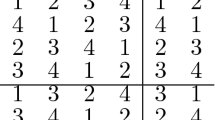Abstract
In some crossover experiments, particularly in medical applications, subjects may fail to complete their sequences of treatments for reasons unconnected with the treatments received. A method is described of assessing the robustness of a planned crossover design, with more than two periods, to subjects leaving the study prematurely. The method involves computing measures of efficiency for every possible design that can result, and is therefore very computationally intensive. Summaries of these measures are used to choose between competing designs. The computational problem is reduced to a manageable size by a software implementation of Polya theory. The method is applied to comparing designs for crossover studies involving four treatments and four periods. Designs are identified that are more robust to subjects dropping out in the final period than those currently favoured in medical and clinical trials.
Similar content being viewed by others
References
Ballinger, C., Pickering, R. M., Bannister, S. and McLellan D. L. (1995) Evaluating equipment for people with disabilities: user and technical perspectives of commodes. Clinical Rehabili-tation, 9, 157–66.
Hall, F. M. (1972) An introduction to abstract algebra, vol. 1. Cambridge: Cambridge University Press.
Herzberg, A. M. and Andrews, D. F. (1976) Some considerations in the optimal design of experiments in non-optimal situa-tions. J. Roy. Statist. Soc. B, 38, 284–89.
Jacroux, M. (1983) Some minimum variance block designs for estimating treatment differences. J. Roy. Statist. Soc. B, 70–76.
Jones, B. and Kenward, M. G. (1989) Design and Analysis of Cross-Over Trials. London: Chapman and Hall.
Kiefer, J. (1975) Construction and optimality of generalised Youden designs. In A Survey of Statistical Designs and Linear Models (ed. J. N. Srivastava), pp 333–53. Amsterdam: North Holland.
Low, J. L., Lewis S. M., McKay B. D. and Prescott, P. (1994) Computational issues for cross-over designs subject to dropout. In Proceedings in Computational Statistics, pp 423–28. Heidelberg: Physica-Verlag.
Low, J. L., Lewis S. M., and Prescott. P. (1998) An application of Polya theory to crossover designs with dropout. Technical report number 294, Department of Mathematics, South-ampton University, Southampton.
Gough, K. (1994) Discussion of Informative dropout in longitudi-nal data analysis by P. Diggle and M. G. Kenward. J. Roy. Statist. Soc. C, 43, 83.
Matthews, J. N. S. (1988) Recent developments in crossover de-signs. International Statistical Review, 56, 117–27.
Willan, A. R. and Pater, J. L. (1986) Carryover and the two-period crossover design. Biometrics, 42, 593–99.
Rights and permissions
About this article
Cite this article
Low, B.J.L., Lewis, S.M. & Prescott, P. Assessing robustness of crossover designsto subjects dropping out. Statistics and Computing 9, 219–227 (1999). https://doi.org/10.1023/A:1008974031782
Issue Date:
DOI: https://doi.org/10.1023/A:1008974031782




